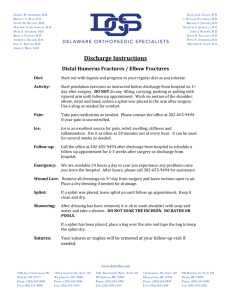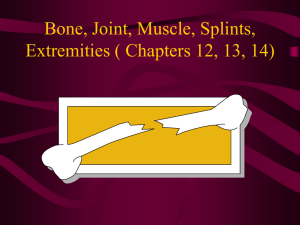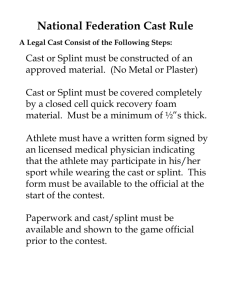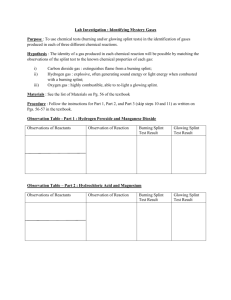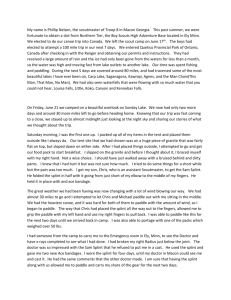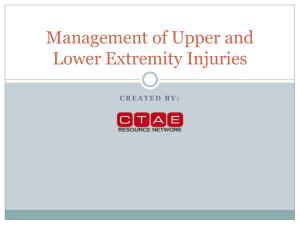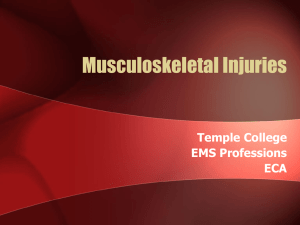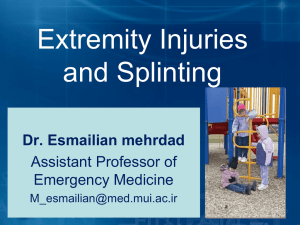27Altman.CPR.03.05.12.Muscle.Bone.JointInjuries
advertisement
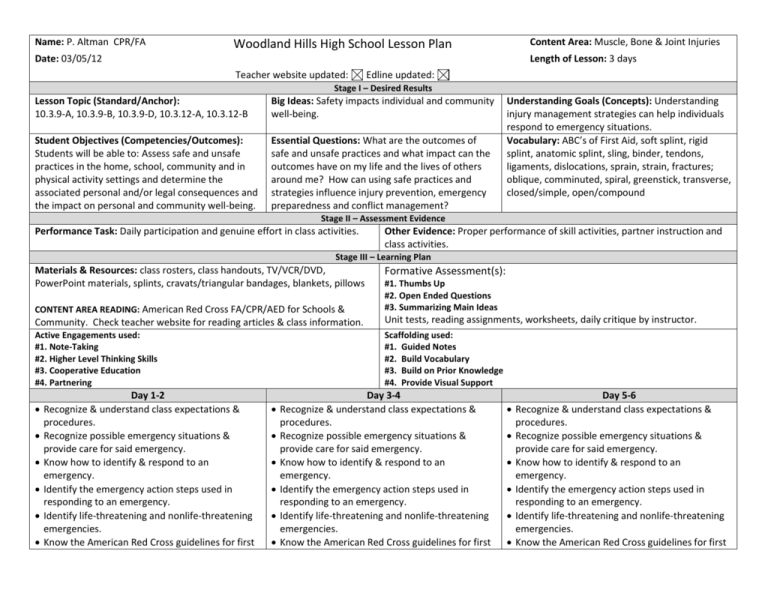
Name: P. Altman CPR/FA Content Area: Muscle, Bone & Joint Injuries Woodland Hills High School Lesson Plan Date: 03/05/12 Length of Lesson: 3 days Teacher website updated: Edline updated: Stage I – Desired Results Lesson Topic (Standard/Anchor): 10.3.9-A, 10.3.9-B, 10.3.9-D, 10.3.12-A, 10.3.12-B Big Ideas: Safety impacts individual and community well-being. Student Objectives (Competencies/Outcomes): Students will be able to: Assess safe and unsafe practices in the home, school, community and in physical activity settings and determine the associated personal and/or legal consequences and the impact on personal and community well-being. Essential Questions: What are the outcomes of safe and unsafe practices and what impact can the outcomes have on my life and the lives of others around me? How can using safe practices and strategies influence injury prevention, emergency preparedness and conflict management? Understanding Goals (Concepts): Understanding injury management strategies can help individuals respond to emergency situations. Vocabulary: ABC’s of First Aid, soft splint, rigid splint, anatomic splint, sling, binder, tendons, ligaments, dislocations, sprain, strain, fractures; oblique, comminuted, spiral, greenstick, transverse, closed/simple, open/compound Stage II – Assessment Evidence Performance Task: Daily participation and genuine effort in class activities. Other Evidence: Proper performance of skill activities, partner instruction and class activities. Stage III – Learning Plan Materials & Resources: class rosters, class handouts, TV/VCR/DVD, PowerPoint materials, splints, cravats/triangular bandages, blankets, pillows CONTENT AREA READING: American Red Cross FA/CPR/AED for Schools & Formative Assessment(s): #1. Thumbs Up #2. Open Ended Questions #3. Summarizing Main Ideas Community. Check teacher website for reading articles & class information. Unit tests, reading assignments, worksheets, daily critique by instructor. Active Engagements used: #1. Note-Taking #2. Higher Level Thinking Skills #3. Cooperative Education #4. Partnering Scaffolding used: #1. Guided Notes #2. Build Vocabulary #3. Build on Prior Knowledge #4. Provide Visual Support Day 1-2 Recognize & understand class expectations & procedures. Recognize possible emergency situations & provide care for said emergency. Know how to identify & respond to an emergency. Identify the emergency action steps used in responding to an emergency. Identify life-threatening and nonlife-threatening emergencies. Know the American Red Cross guidelines for first Day 3-4 Recognize & understand class expectations & procedures. Recognize possible emergency situations & provide care for said emergency. Know how to identify & respond to an emergency. Identify the emergency action steps used in responding to an emergency. Identify life-threatening and nonlife-threatening emergencies. Know the American Red Cross guidelines for first Day 5-6 Recognize & understand class expectations & procedures. Recognize possible emergency situations & provide care for said emergency. Know how to identify & respond to an emergency. Identify the emergency action steps used in responding to an emergency. Identify life-threatening and nonlife-threatening emergencies. Know the American Red Cross guidelines for first aid and care. Identify the signs of muscle, bone or joint injury. Demonstrate how to care for various muscle, bone and joint injuries. Review folding triangular bandage, tie a square knot w/release and a surgeon’s knot. Demonstrate splinting techniques; soft splint, rigid splint, anatomic splint, sling & binder. Student Assignments Follow class expectations & safety guidelines. Participate to the best of your ability. Follow class safety protocols. Complete all class assignments. aid and care. Identify the signs of muscle, bone or joint injury. Demonstrate how to care for various muscle, bone and joint injuries. Review folding triangular bandage, tie a square knot w/release and a surgeon’s knot. Demonstrate splinting techniques; soft splint, rigid splint, anatomic splint, sling & binder. Student Assignments Follow class expectations & safety guidelines. Participate to the best of your ability. Follow class safety protocols. Complete all class assignments. aid and care. Identify the signs of muscle, bone or joint injury. Demonstrate how to care for various muscle, bone and joint injuries. Review folding triangular bandage, tie a square knot w/release and a surgeon’s knot. Demonstrate splinting techniques; soft splint, rigid splint, anatomic splint, sling & binder. Written exam on muscle, bone & joint injuries. Student Assignments Follow class expectations & safety guidelines. Participate to the best of your ability. Follow class safety protocols. Complete all class assignments.


